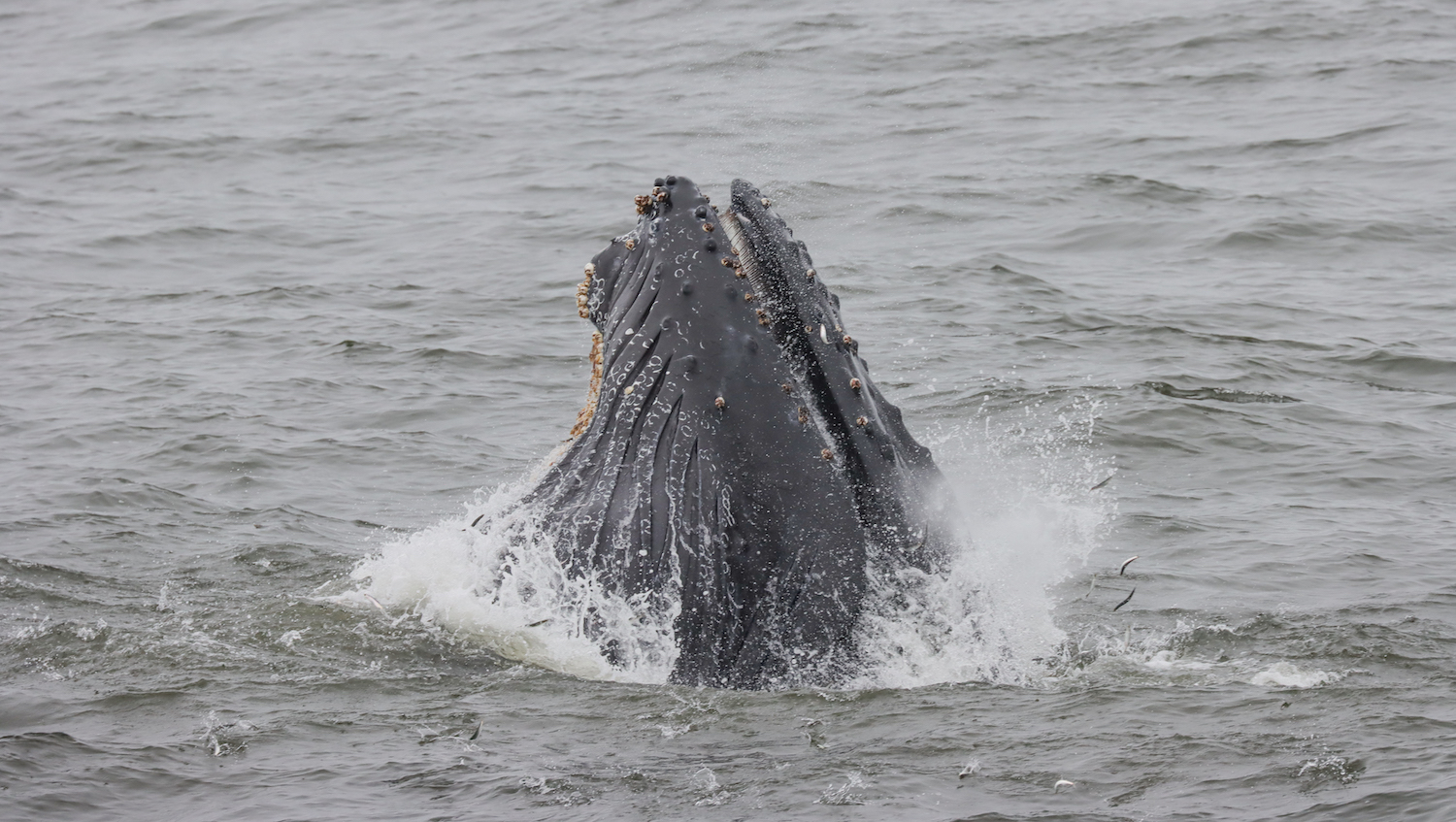In dense fog 30 miles out from the Golden Gate Bridge, the 50,000-pound humpback whale’s leap out of the water is almost totally silent, maybe 300 feet away. Its motion is as smooth and natural as an exhalation; its ribbed body arcs and cascades back into the mirrored sea. Seconds later, the only sign it was there at all is my fast-beating heart.
Meanwhile, our boat, the research vessel Fulmar, continues motoring ahead against the swells of the San Francisco Bay. If we want to understand what that lone humpback whale means in the ocean’s broader story, we have a schedule to keep.
For the past 20 years, scientists have been motoring transects—straight lines across the water—to count whales like this humpback, as well as anything else they see along the way, whether bird or balloon. They cast fine nets to see what small things live in the deep; they measure variables like salinity and temperature. All to produce an annual health check for this part of the eastern Pacific Ocean. These cruises—known as the Applied California Current Ecosystems Studies, or ACCESS—are a collaboration between the Petaluma-based nonprofit Point Blue Conservation Science, the U.S. National Oceanic and Atmospheric Administration, and the Cordell Bank and Greater Farallones national marine sanctuaries. Through these surveys, scientists have watched the ocean go through seismic shifts over the last two decades. And one of the most marked changes they’ve observed is how humpback whales shifted towards land after the 2014–2016 marine heatwave, often called the Blob.
It’s a change unmistakable to not only marine biologists out at sea, but citizens and scientists standing on solid ground. This year in particular has been a “banner year” for humpback whales, says Bill Keener, a marine biologist with the Marine Mammal Center, a Sausalito-based nonprofit. At places like Pacifica’s pier, thousands of people have witnessed the whales over the last few months—surfacing their smooth backs, lunging, diving, bubble-feeding—sometimes in unprecedented numbers, sometimes with tens of whales gathering at a time.
Scientists hope that documenting these whales’ changing patterns can help improve how we coexist with our largest living relatives. “We cannot cool down the ocean,” says Jaime Jahncke, one of the scientists who helped start the ACCESS cruises. “But we can change the way we use the ocean.”

A whale of a buffet
Before the Blob, only lost humpback whales ended up in the Bay, as they journeyed from baby-making summers off Mexico’s coast to frigid feasts in the Bering Sea. Keener remembers the moment in May 2016 when he saw a humpback whale lunge up under the Golden Gate Bridge, where he’d been surveying harbor porpoises for years. “I was shocked,” he says.
Even more surprising than the whales’ arrival was the fact that they stayed, often for months. And then—another shocker—the whales returned the next year. Then they came back the year after that, and the year after that. Their presence in the Bay has been metronomic since 2016. And the ACCESS data has illuminated the larger story that these near-shore whales are part of.
At the furthest point of our cruise, the scientists toss long, windsock-like nets into the water. An hour later, they reel up the nets, carefully rinsing out a blushed mass of krill from the bottom. As the boat rushes to our next survey point, Jahncke balances the tiny, shrimplike creatures on the tip of his finger to photograph, identify, and measure.


Left: Jaime Jahncke sorts krill and other critters pulled up from the deep. Right: A krill perched atop Jahncke’s finger. (Tanvi Dutta Gupta)
These small creatures are critical to understanding what our biggest mammals could be eating out here. These nets helped show how the Blob reshaped the deep ocean: large adult krill vanished, while see-through jellies boomed. For blue whales, which specialize in krill, life probably got a lot tougher.
But humpback whales aren’t as picky, and so when krill got scarce, the humpies seemed to have jumped—literally—on a nearshore fishy bounty. Anchovy shoals had in the meantime begun to press north and closer to shore, chasing cooler water. Though neither marine scientists nor onshore ones directly track whale diets, the humpbacks’ meals have been unmistakable: Pierside whale-watchers see the small fish flash silver as they spray out of gaping whale mouths.

Humpback whales’ new and lengthening Bay forays present fresh challenges for humans and cetaceans alike. The closer to shore whales move, the more often they cross some of the busiest shipping routes in the United States, raising the likelihood a cargo vessel runs into them. They also risk entanglement in the lines of Dungeness crabbers ^(https://www.blogquicker.com/goto/https://baynature.org/article/whales-and-crabs/), as Bay Nature has reported. Whales’ nearshore arrival has closed the season early for five years now, frustrating fishermen. The data from the cruises helps establish where marine life hotspots are, which helps the national marine sanctuaries and the Coast Guard tell ships and fishing boats where to move more cautiously.
Sign up today! ^(https://www.blogquicker.com/goto/https://baynature.org/sign-up-for-connections/)

Short-term funding for long-term data
When it comes to the animals that live in the deepest, most alien parts of the ocean, this science provides a tantalizing glimpse of puzzle pieces, while the final picture keeps changing out of sight. But each year of data helps a little more. Now scientists can compare a survey done today to a survey done at the same place in 2004. It allows them, Jahncke says, to “see what things are extraordinary.”
Parts of the survey are modeled after a similar one known as CalCOFI that focuses on the southern and central California coast. In the world of long-term ocean monitoring, CalCOFI, which dates back to 1949, is a “boomer,” says Jahncke. The Bay Area survey is more of a Gen Z-er—it still has a lot to learn. Twenty years is not long for a long-term dataset.
Each of those years has been hard-won, as the ACCESS cruise depends on private donors to happen (unlike CalCOFI, a federal-state partnership with more stable public funding). Existential threat looms each fundraising cycle.


Left: Jaime Jahncke sorts krill and other critters pulled up from the deep. Right: A krill perched atop Jahncke’s finger. (Tanvi Dutta Gupta)
From the top deck of the Fulmar, though, as scientists watch for whales, such concerns feel very far away. All our eyes are focused on the water, watching for the shiver of a phalarope flying by or the tell-tale cloud of a whale spout. The ocean was a maelstrom of dolphins on our way to the transect, with hundreds leaping in every direction. Six sunfish (Mola mola) flapped to the surface, looking like finned dinner plates. But over the length of the transect, it’s still; the scientists officially count four whales by the end of the day.
These quiet hours still help assemble the much larger picture of the changing oceans. Will the whales return to Pacifica next year? No one can say for sure. In our modern climate system, the only constant is change; the extraordinary is becoming more ordinary.
At the end of the Fulmar’s last transects, two humpback whales appear. At first they’re a half-mile away, but they dive and get closer and closer to us—till they surface less than a boat-length away. We see the entire slick length of their bodies. Diving, they ripple quietly down to the deep. I let out a deep breath of my own and I realize: out here, the ordinary has been extraordinary all along.

#Backstory #Pacificas #Whale #Bonanza



